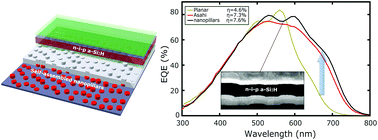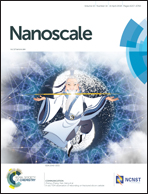Light trapping in thin film silicon solar cells via phase separated disordered nanopillars†
Abstract
In this work, we have improved the absorption properties of thin film solar cells by introducing light trapping reflectors deposited onto self-assembled nanostructures. The latter consist of a disordered array of nanopillars and are fabricated by polymer blend lithography. Their broadband light scattering properties are exploited to enhance the photocurrent density of thin film devices, here based on hydrogenated amorphous silicon active layers. We demonstrate that these light scattering nanopillars yield a short-circuit current density increase of +33%rel with respect to equivalent solar cells processed on a planar reflector. Moreover, we experimentally show that they outperform randomly textured substrates that are commonly used for achieving efficient light trapping. Complementary optical simulations are conducted on an accurate 3D model to analyze the superior light harvesting properties of the nanopillar array and to derive general design rules. Our approach allows one to easily tune the morphology of the self-assembled nanostructures, is up-scalable and operated at room temperature, and is applicable to other photovoltaic technologies.



 Please wait while we load your content...
Please wait while we load your content...